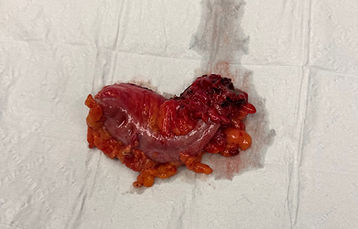
Mass General Hospital
A Removed Parathyroid
This is a parathyroid that was removed during a parathyroidectomy. It is nearly 3x the average size of a typical parathyroid. The parathyroid is enlarged so much that it became a tumor. As a result, too much parathyroid hormone was produced, which removes calcium from the bones, leading to conditions like osteoporosis.

The Basement of MGH
I received a tour of the basement, which includes a large area dedicated to surgical sterilization and storage. This is where all equipment, both reusable and non-reusable, is held. There are machines for sterilizing, cleaning, and fixing materials.

O.R. Storage Closet
This is a closet in the operating room containing mainly different types of suture kits, which include thread, needles, and scalpels.

Future Surgeon
This is me geared up to enter the operating room. Surgeons wear this too underneath their sterile gown.

Surgical Setup
Sterilized surgical tools, including forceps, gauze, and scalpels, are laid out on the blue drapes, which are part of the sterile field. People who are not scrubbed in can not touch the blue drapes or anything on them.

Large Intestine
This is a portion of the large intestine that was removed during a colectomy. It was removed due to radiation damage. The pink in the middle is the actual organ, and the orange surrounding it is fat.

My time at MGH was absolutely amazing. I was interning with Dr. Stephen, an endocrine surgeon. Because she’s in the general surgery department, I was also able to shadow surgeons in other specialties. Having the opportunity to observe invasive surgeries which were designed to save lives was incredibly impactful, and I was privileged in that every operation I watched had a positive outcome. I observed parathyroidectomies and thyroidectomies, a colectomy, which is when part of the large intestine is removed, a colostomy, a gallbladder removal, and a tracheal resection to remove a tumor that was obstructing the airway. I watched a double mastectomy and the breast reconstruction that followed, and I witnessed a robotic thymectomy, which is a cardiothoracic procedure that is done robotically—the surgeon didn’t even touch the patient. The most amazing operation by far, though, was a craniotomy, which is open-skull neurosurgery to remove a brain tumor.
What I loved most about being in the operating room, besides watching the doctors literally cut and sew organs, was noticing how the surgical team interacted with the patient before and afterwards. They were compassionate, took the time to explain all the medical terminology in understandable words, and held every patient’s hand as they fell asleep. The surgeons understand that a normal day for them is the scariest day of their patient’s life.
In addition to watching surgery, I also had the opportunity to shadow a breast cancer surgeon during a conference and clinic that she was leading. I learned that I love both surgery and clinical medicine, where you can build relationships with your patients. Overall, every minute at MGH was incredible.